Lecture1-Introduction(2)PPT课件
合集下载
财务管理Lecture1
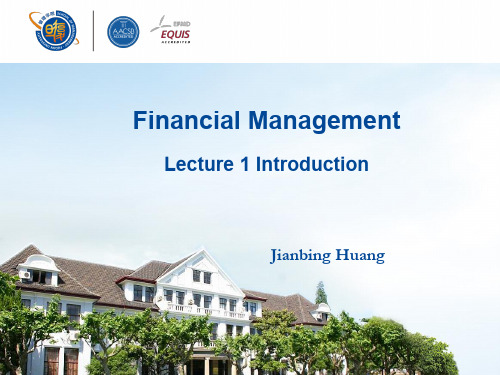
Financial Management
Lecture 1 Introduction
Jianbing Huang
2014/2/28
1-0
Road Map
• Part A: Introduction of Financial Management Objective of manager and role of financial markets Given cash flows and discount rates, finding present value • Part B: Valuation of Financial Securities • Part C: Analysis of the determination of risk-adjusted discount rates • Part D: Analyze how a firm’s financial decisions affect its value
2014/2/28
1-8
Course Objective
• The objective: provide you with an understanding of the basic theory and the tools necessary to make good financial decisions. • Finance is really about value Firms Projects and real investments Securities • Central question How can we create value through investment and financing decisions?
Lecture 1 Introduction
Jianbing Huang
2014/2/28
1-0
Road Map
• Part A: Introduction of Financial Management Objective of manager and role of financial markets Given cash flows and discount rates, finding present value • Part B: Valuation of Financial Securities • Part C: Analysis of the determination of risk-adjusted discount rates • Part D: Analyze how a firm’s financial decisions affect its value
2014/2/28
1-8
Course Objective
• The objective: provide you with an understanding of the basic theory and the tools necessary to make good financial decisions. • Finance is really about value Firms Projects and real investments Securities • Central question How can we create value through investment and financing decisions?
Lecture 1-2.ppt
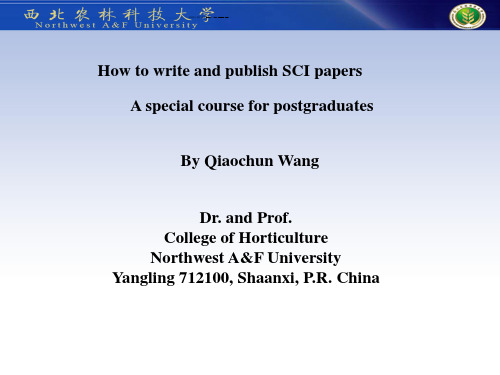
target journal
a. Scientia Horticulturae is an international journal publishing research related to horticultural crops. b. Papers in related areas (biochemistry, micropropagation, soil science, plant breeding, plant physiology, phytopathology, etc.) are considered, if they contain information of direct significance to horticulture. c. Papers describing the processing of the product of horticultural crops will not be considered for publication. d. The scope of the journal includes all horticultural crops but does not include special crops such as, medicinal crops or forestry crops, such as bamboo.
Time length
60 days 40 days (even longer) 7 days (Simplest) 7 days (shortest) 21 days 14 days 142 days (5 months)
Chapter 3. How to choose the target journal
C. Difficulty A naturalist’s life would be a happy one if she/he had only to observe and never to write (Charles Darwin).
a. Scientia Horticulturae is an international journal publishing research related to horticultural crops. b. Papers in related areas (biochemistry, micropropagation, soil science, plant breeding, plant physiology, phytopathology, etc.) are considered, if they contain information of direct significance to horticulture. c. Papers describing the processing of the product of horticultural crops will not be considered for publication. d. The scope of the journal includes all horticultural crops but does not include special crops such as, medicinal crops or forestry crops, such as bamboo.
Time length
60 days 40 days (even longer) 7 days (Simplest) 7 days (shortest) 21 days 14 days 142 days (5 months)
Chapter 3. How to choose the target journal
C. Difficulty A naturalist’s life would be a happy one if she/he had only to observe and never to write (Charles Darwin).
DS&AL_Lecture1-1--Introduction
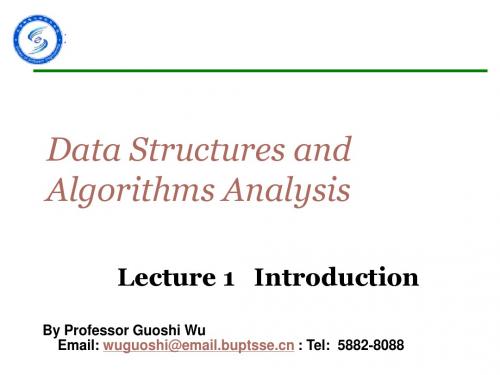
Machine Learning and Data Mining: Methods and application
Author
Mark Allen Weiss
Publisher Descri ption
Posts &Telecom Press
002
Conclusion 2: Data should be organized for the reason of efficient operation.
Conclusion 1: Unorganized data can not represent information very clearly.
1/17/2011 BUPTSSE 4
What is a Data Structure ?
Example 2
Book ID 001 Book name Data structures and algorithm Analysis in C
This information may be in the form of text documents, images, audio clips, software programs, or other types of data. A data set in a classroom ={ desk 1, desk 2,…chair 1, chair 2…,stud 1, stud 2,…}
Data Element
StudentID First name Last name age 1001 1002 1002
1/17/2011
mark Edwin …
Li zhang ….
BUPTSSE
20 22 ….
Author
Mark Allen Weiss
Publisher Descri ption
Posts &Telecom Press
002
Conclusion 2: Data should be organized for the reason of efficient operation.
Conclusion 1: Unorganized data can not represent information very clearly.
1/17/2011 BUPTSSE 4
What is a Data Structure ?
Example 2
Book ID 001 Book name Data structures and algorithm Analysis in C
This information may be in the form of text documents, images, audio clips, software programs, or other types of data. A data set in a classroom ={ desk 1, desk 2,…chair 1, chair 2…,stud 1, stud 2,…}
Data Element
StudentID First name Last name age 1001 1002 1002
1/17/2011
mark Edwin …
Li zhang ….
BUPTSSE
20 22 ….
Lecture 1-Introduction
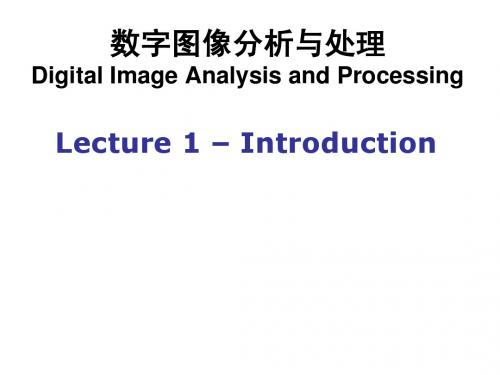
Imaging in the Visible and Infrared Bands
Sources of Images
Imaging in the Visible and Infrared Bands
Sources of Images
Imaging in the Visible and Infrared Bands
• •
Human Vision System Mathematicians
•
Prior Knowledge Image models Transformations Methodologies
Impacts?
• • •
Categorization – My Viewpoint
•
Image Processing Methodologies
About This Course
Resources?
Scoring policy
Presence – 15% Final exam – 85%
Course Outline
32 hours = 3×10 lectures + 2 for course review Lecture 1 – Introduction Lecture 2 – Digital Image Fundamentals Lecture 3 – Image Transformations Lecture 4 – Image Enhancement Lecture 5 – Image Restorations Lecture 6 – Color Image Processing Lecture 7 – Image Compression Morphological Image Processing Lecture 8 – Image Segmentation Lecture 9 – Representation and Description Lecture 10 – Image Recognition
Lecture1_Introduction简介

• Money market mutual funds allow individuals to access the money market.
2-22
Money Market Securities
• Treasury bills: Short-term debt of U.S. government • Certificates of Deposit: Time deposit with a bank • Commercial Paper: Short-term, unsecured debt of a company
• Consumption Timing: Use securities to store wealth and transfer consumption to the future
1-10
Financial Markets and the Economy (Ctd.) • Allocation of Risk: Investors can select securities consistent with their tastes for risk • Separation of Ownership and Management: With stability comes agency problems
1-8
Common Stock and Derivatives
• Common Stock is equity or ownership in a corporation.
– Payments to stockholders are not fixed, but depend on the success of the firm
• Securitization: Fannie Mae and Freddie Mac bought mortgage loans and bundled them into large pools • Mortgage-backed securities are tradable claims against the underlying mortgage pool • “Originate to distribute” • Credit Default Swaps (CDS)
google云计算系列课程第一讲:介绍PPT课件

What is the key attribute that all these examples have in common?
8
Parallel vs. Distributed
Parallel computing can mean:
Vector processing of data Multiple CPUs in a single computer
3
Computer Speedup
Moonsistors on a chip doubles every 18 months, for the same cost” (1965)
Image: Tom’s Hardware and not subject to the Creative 4 Commons license applicable to the rest of this work.
applicable to the rest of this work.
10
A Brief History… 1985-95
“Massively parallel architectures” start rising in prominence
Distributed computing is multiple CPUs across many computers over the network
9
A Brief History… 1975-85
Parallel computing was favored in the early years
1
Course Overview
5 lectures
1 Introduction 2 Technical Side: MapReduce & GFS 2 Theoretical: Algorithms for distributed
8
Parallel vs. Distributed
Parallel computing can mean:
Vector processing of data Multiple CPUs in a single computer
3
Computer Speedup
Moonsistors on a chip doubles every 18 months, for the same cost” (1965)
Image: Tom’s Hardware and not subject to the Creative 4 Commons license applicable to the rest of this work.
applicable to the rest of this work.
10
A Brief History… 1985-95
“Massively parallel architectures” start rising in prominence
Distributed computing is multiple CPUs across many computers over the network
9
A Brief History… 1975-85
Parallel computing was favored in the early years
1
Course Overview
5 lectures
1 Introduction 2 Technical Side: MapReduce & GFS 2 Theoretical: Algorithms for distributed
国际学术会议英语课件Chapter1Introduction

Sample demonstration
I. Listen to the following six passages of introductions in an oral presentation and then match the numbers of the passage on the left column with the topics (A-F) on the right column.
Passage 3 C. Saying what you plan to do in your presentation and why
Passage 4 D. Getting the audience to do something Passage 5 E. Getting the audience to imagine situations
Number of the passage
The skills the speakers use
Passage 1 A. Saying something personal about yourself
Passage 2
B. Asking the audience a question or get them to raise their hands
▪ In the Conclusion it should pick out the main points from the main body and summarize them for your audience. So the conclusion is similar to the Introduction in fact.
Passage 6 F. Giving interesting facts that relates directly to the audience
Lecture 1-2 introduction module0
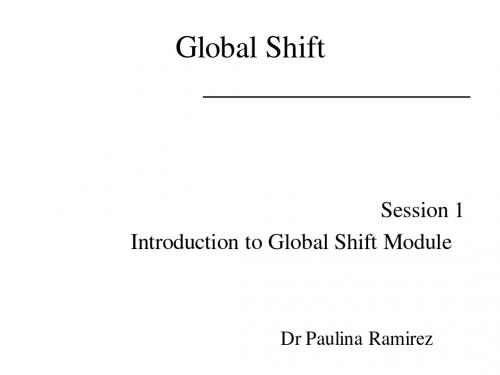
• (see Dunning 1997, 2000; Dicken 2007, Lundvall and Borras 1997)
The study of these changes is difficult because:
• The changes are multidimensional and inter-related so difficult to see how they operate on whole system • Changes studied by different disciplines (e.g. management, economist, political scientists, cultural studies, sociologists, etc). Each has own focus of interests, definitions, data, etc. • Many of these changes are processes (rather than one-off events), so not clear what the end result will be. Could they be reversed? • There are differences of opinions about the significance of these changes • Differences of opinion about whether changes are ‘good’ or ‘bad’ and who benefits?
What is the point of the Lectures? • Introduce main topic and how this will be approached • It is the foundation for and direction for independent study. • They are only a rough guide What will we do in seminars? • Seminars is where we discuss important issues raised by lectures or readings in more depth. • It is where we will answer your questions… Use them properly!!! • You are expected to prepare all seminars • Discussion and preparation done for seminars will feed into assessment (Exam) Reading • You have to read and engage with texts recommended for course in lectures, handouts and course outline…but should read more
Lecture英文介绍信 ppt课件

Chapter 7 英文介绍信
如何写介绍信
介绍信是介绍本单位人员到外单位参 观学习、联系工作、了解情况或出席 某种会议等所写的一种书信。介绍信 具有介绍和证明的作用。使用介绍信, 可以使对方了解来人的身份和目的, 以便得到对方的信任和支持。对一个 从事文案工作的员工来说,介绍信可 是一定要会写的。
Dear Sherry,
I want to introduce to you the bearer of this letter, my younger sister, Linda. She is going to take one-month training in Nanjing University. She is a lively and lovely girl, whom I am sure you will like to make friends with.
But since it is the first time she goes to a strange city, I am a little worried. I would be ever so obliged if you would be so kind as to meet her at the railway station and accompany her to Nanjing University to register for the course. She will have no problem with her accommodation. I hope it will not cause any inconvenience for you. By the way, my sister’s mobile phone number is .
如何写介绍信
介绍信是介绍本单位人员到外单位参 观学习、联系工作、了解情况或出席 某种会议等所写的一种书信。介绍信 具有介绍和证明的作用。使用介绍信, 可以使对方了解来人的身份和目的, 以便得到对方的信任和支持。对一个 从事文案工作的员工来说,介绍信可 是一定要会写的。
Dear Sherry,
I want to introduce to you the bearer of this letter, my younger sister, Linda. She is going to take one-month training in Nanjing University. She is a lively and lovely girl, whom I am sure you will like to make friends with.
But since it is the first time she goes to a strange city, I am a little worried. I would be ever so obliged if you would be so kind as to meet her at the railway station and accompany her to Nanjing University to register for the course. She will have no problem with her accommodation. I hope it will not cause any inconvenience for you. By the way, my sister’s mobile phone number is .
开放英语1 的讲义38页PPT

▪ Language Focus
1、 动词need need + 动词不定式: 其结构是: “主语 + need +to + 动词”。 主语是第三人称单数时,need 要加-s。
例如: I need to buy a carton of cream. You need to get some prawns. She needs to buy oil. He needs to get some apples. We need to get some oranges. They need to buy a bottle of wine.
a canton of cream(一盒奶油)
a cup of tea(一杯茶)
a bag of apples(一袋苹果)
在餐馆点咖啡或茶的时候,也可以说 two coffees 或 two teas,意思是 two cups of coffee 或 two cups of tea,表示两杯咖啡或两 杯茶。
开放英语1 的讲义
•
46、寓形宇内复几时,曷不委心任去 留。
•
47、采菊东篱下,悠然见南山。
•
48、啸傲东轩下,聊复得此生。
•
49、勤学如春起之苗,不见其增,日 有所长 。
•
50、环堵萧然,不蔽风日;短褐穿结 ,箪瓢 屡空, 晏如也 。
开放英语1 讲义
This is English 1
Unit 10 An Invitation 请客
在英语中,名词分为可数名词和不 可数名词。在词典里,用 C 和 U 标 示,C表示可数名词,U表示不可数 名词。例如:prawn [C],milk [U]。
▪ 可数名词: ▪ apple 是可数名词,其复数形式是apple + s
电气工程专业-英语PPT优质课件
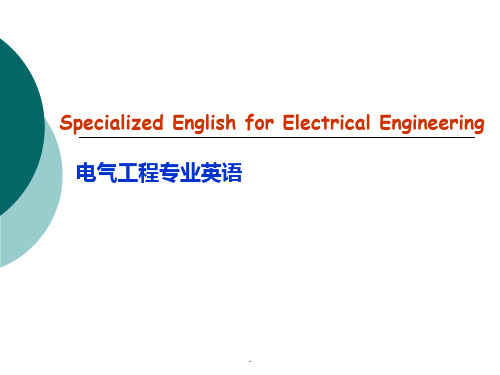
.
2.1 Grammar Features
3) The device includes an instrument transformation and a relay system which has two circuits in it.
The device includes an instrument transformation and a relay system with two circuits in it.
.
2.1 Grammar Features
③ 不定式
用不定式短语来替代表示目的和功能的从句或语句 (1) The capacity of individual generators is larger and larger so that the increasing demand of electric power is satisfied. The capacity of individual generators is larger and larger to satisfy the increasing demand of electric power.
专业英语(English for Special Science and Technology)
隶属于科技英语 是科技英语的一部分,以表达科技概念、理论与事实为主要 目的。遵守科技英语的语法体系和翻译方法;特别注重客观事实和真理,表达准 确、精练和正式。
是结合各自专业的科技英语 有很强的专业性,涉及的面更加狭窄,与专业内 容配合更为密切。
(3) 省略句使用频繁 (精炼) 省略成分:状语从句中的主语、全部或部分谓语;定语从句中的关系代词 which和that、从句中的助词等;还常用介词短语替代从句。
2.1 Grammar Features
3) The device includes an instrument transformation and a relay system which has two circuits in it.
The device includes an instrument transformation and a relay system with two circuits in it.
.
2.1 Grammar Features
③ 不定式
用不定式短语来替代表示目的和功能的从句或语句 (1) The capacity of individual generators is larger and larger so that the increasing demand of electric power is satisfied. The capacity of individual generators is larger and larger to satisfy the increasing demand of electric power.
专业英语(English for Special Science and Technology)
隶属于科技英语 是科技英语的一部分,以表达科技概念、理论与事实为主要 目的。遵守科技英语的语法体系和翻译方法;特别注重客观事实和真理,表达准 确、精练和正式。
是结合各自专业的科技英语 有很强的专业性,涉及的面更加狭窄,与专业内 容配合更为密切。
(3) 省略句使用频繁 (精炼) 省略成分:状语从句中的主语、全部或部分谓语;定语从句中的关系代词 which和that、从句中的助词等;还常用介词短语替代从句。
Lecture 1- Introduction

• Exchange: The process by which some transfer for value occurs between a buyer and a seller.
Currency
Goods or services
New behavior
The item of value
The Evolution of a Concept
The Production era
The Selling era
Dynamic process
The Relationship era
Buyer’s market? Seller’s market?
Definition
Marketing is a societal process by which individuals and groups obtain what they need and want through creating, offering, and exchanging products and services of value freely with others.
The value of marketing
2. Marketing is about creating utility
• Utility is the usefulness consumers receive from buying, owning or consuming a product
Form utility: raw materials into finished products
Understand value from the perspectives of customers, producers and society Define what marketing is, and describe how it provides value to everyone involved in the marketing process Describe the evolution of the marketing concept Discuss the range of services and goods that are marketed
Currency
Goods or services
New behavior
The item of value
The Evolution of a Concept
The Production era
The Selling era
Dynamic process
The Relationship era
Buyer’s market? Seller’s market?
Definition
Marketing is a societal process by which individuals and groups obtain what they need and want through creating, offering, and exchanging products and services of value freely with others.
The value of marketing
2. Marketing is about creating utility
• Utility is the usefulness consumers receive from buying, owning or consuming a product
Form utility: raw materials into finished products
Understand value from the perspectives of customers, producers and society Define what marketing is, and describe how it provides value to everyone involved in the marketing process Describe the evolution of the marketing concept Discuss the range of services and goods that are marketed
Lecture 2 introduction to culture language and Culture 语言与文化 教学课件

6
(1) In the broad sense, Culture refers to the combined material and spiritual wealth created by human in the process of social and historical development.
9
4. Based on different time periods, culture can be classified into ancient culture, Edwardian culture, late Qing culture, etc.
5. Based on the functioning of groups and organizations, culture can be classified into corporate culture, school culture, class culture, etc.
(The classification is used by the UNESCO to classify the World Cultural Heritages.)
8
3. Based on the relative position in the world,
culture can be classified into eastern culture and western culture; Asian culture, European culture, African culture… Chinese culture, American culture, English culture, Italian culture… southern culture, Northwestern culturvs. Western culture
(1) In the broad sense, Culture refers to the combined material and spiritual wealth created by human in the process of social and historical development.
9
4. Based on different time periods, culture can be classified into ancient culture, Edwardian culture, late Qing culture, etc.
5. Based on the functioning of groups and organizations, culture can be classified into corporate culture, school culture, class culture, etc.
(The classification is used by the UNESCO to classify the World Cultural Heritages.)
8
3. Based on the relative position in the world,
culture can be classified into eastern culture and western culture; Asian culture, European culture, African culture… Chinese culture, American culture, English culture, Italian culture… southern culture, Northwestern culturvs. Western culture
Lecture 1 introduction
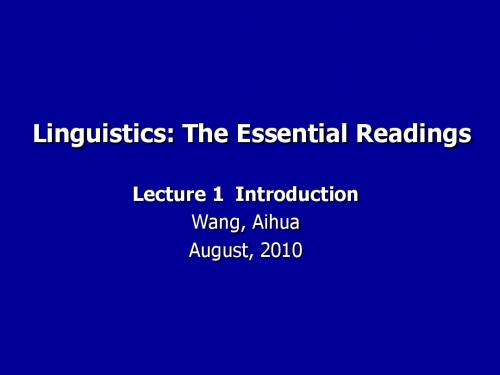
Reading list
Cratylus by Plato 2. On Interpretation by Aristotle
1.
3.
Augustine’s view of language (De Magistro; Confessions)
4.
5.
An Essay Concerning Human Understanding by
6.
Reading list
7. 8.
9.
10.
11.
12. 13.
A set of postulates for the science of language by Bloomfield The Faculty of Language by Chomsky, et al Language, mind and reality by Whorf closing statement: linguistics and poetics by Jakobson Halliday’s view of language (two excerpts) Philosophical Investigation by Wittgenstein How to do things with words by Austin
Views of language
The factory and city metaphors suggest the stratification of languages, artifacts among the most ancient in universal history. The archive metaphor Languages are compared to archives where the memory of humankind is preserved. The track metaphor Languages are compared to tracks left by a man in the desert, which he uses to find his way back. The Monetary metaphor Verbal commerce is compared to the circulation of currency and lies to fake coins.
- 1、下载文档前请自行甄别文档内容的完整性,平台不提供额外的编辑、内容补充、找答案等附加服务。
- 2、"仅部分预览"的文档,不可在线预览部分如存在完整性等问题,可反馈申请退款(可完整预览的文档不适用该条件!)。
- 3、如文档侵犯您的权益,请联系客服反馈,我们会尽快为您处理(人工客服工作时间:9:00-18:30)。
• Students will meet in learning groups, in their own time, in the week between lectures in order to discuss and prepare their group essays. Essays are submitted 8 days after the lecture (see timetable in handbook)
• In critiquing the research paper students should rely on their developing knowledge of research methods as well as lively debate in their small group meetings about the effectiveness of the paper.
2020/10/13
Advances - Lectunt’d)
• Each week’s essay should include a) a critique of the aspects of research methods covered in the previous lecture, plus b) a critique of the relevant research paper. The word length guidance is 800 words – 400 words on research methods and 400 words on the critique.
ADVANCES
Lecture 1 INTRODUCTION
2020/10/13
Advances - Lecture 1
1
ADVANCES
• Please read the handbook carefully for all the detail of this unit including the Timetable
2020/10/13
Advances - Lecture 1
2
ASSESSMENT 1
(three group essays totalling 2,400 words)
• In the period before Christmas, there will be a onehour lecture every two weeks (six lectures in all). After this Introduction, each subsequent lecture will cover a) different aspects of research methods and b) a review of the previous week’s group essay submissions with generic advice for improvement. In addition, a recent research paper will be uploaded for critical review by the groups to be included in the essay.
• In critiquing aspects of research methods students should consult the essential textbook specified in the handbook plus as many other sources as they can find.
3) Assessment 3 (25%) - an individual proposal for further research (1,500 words) building on progress made in the individual report (25%) to be submitted Wednesday May 9th.
2020/10/13
Advances - Lecture 1
4
ASSESSMENT 1 (cont’d)
• The first two essays (submitted in weeks 41 and 43) will be reviewed on receipt but not marked (i.e. they are practice essays). Major generic pointers will be published on BREO each fortnight and discussed in the next lecture. Groups will be able to use this feedback to improve the quality of their next essay.
• This unit is Enquiry Based Learning – lectures are pointers for group or individual investigations
• Incorporates three assessments points:
1) Assessment 1 (25%) - Three Group essays (800 words each) on Research Methods to be submitted before the Christmas recess – marked as ONE Assessment for each group.
2) Assessment 2 (50%)- an individual Research Report (5000 words) on a topic chosen by each student from within a given set of “Broad Areas”, submitted by Wednesday March 21st
• In critiquing the research paper students should rely on their developing knowledge of research methods as well as lively debate in their small group meetings about the effectiveness of the paper.
2020/10/13
Advances - Lectunt’d)
• Each week’s essay should include a) a critique of the aspects of research methods covered in the previous lecture, plus b) a critique of the relevant research paper. The word length guidance is 800 words – 400 words on research methods and 400 words on the critique.
ADVANCES
Lecture 1 INTRODUCTION
2020/10/13
Advances - Lecture 1
1
ADVANCES
• Please read the handbook carefully for all the detail of this unit including the Timetable
2020/10/13
Advances - Lecture 1
2
ASSESSMENT 1
(three group essays totalling 2,400 words)
• In the period before Christmas, there will be a onehour lecture every two weeks (six lectures in all). After this Introduction, each subsequent lecture will cover a) different aspects of research methods and b) a review of the previous week’s group essay submissions with generic advice for improvement. In addition, a recent research paper will be uploaded for critical review by the groups to be included in the essay.
• In critiquing aspects of research methods students should consult the essential textbook specified in the handbook plus as many other sources as they can find.
3) Assessment 3 (25%) - an individual proposal for further research (1,500 words) building on progress made in the individual report (25%) to be submitted Wednesday May 9th.
2020/10/13
Advances - Lecture 1
4
ASSESSMENT 1 (cont’d)
• The first two essays (submitted in weeks 41 and 43) will be reviewed on receipt but not marked (i.e. they are practice essays). Major generic pointers will be published on BREO each fortnight and discussed in the next lecture. Groups will be able to use this feedback to improve the quality of their next essay.
• This unit is Enquiry Based Learning – lectures are pointers for group or individual investigations
• Incorporates three assessments points:
1) Assessment 1 (25%) - Three Group essays (800 words each) on Research Methods to be submitted before the Christmas recess – marked as ONE Assessment for each group.
2) Assessment 2 (50%)- an individual Research Report (5000 words) on a topic chosen by each student from within a given set of “Broad Areas”, submitted by Wednesday March 21st
